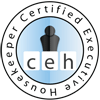[The following instructions are specific to basic ovens without automatic cleaning features. Please see the entry Oven, convection for general tips in cleaning all types of ranges.]
Warning: Ammonia is a strong irritant that can cause serious injury to the eyes and respiratory system. While working with ammonia, always wear a mask as well as skin and eye protection, and ensure adequate ventilation. A large portable fan directed at the work site will provide plenty of fresh air.
Caution: Remove aluminum or nickel-plated racks or other components from the oven before starting. Ammonia will darken these metals permanently.
Before cleaning, open the oven and stand back for a couple of minutes until the ammonia vapors inside the oven dissipate. Use a white nylon pad or plastic scrubber, if needed. More aggressive scouring pads or steel wool will scratch the oven surface, complicating future cleanings. Rinse all surfaces thoroughly with plenty of water to remove all traces of ammonia.
Non-caustic oven cleaners are available for sale, but they won’t work as well as lye-based products do. When the burned-on gunk is so extensive that you must use a lye-based product, make time your ally, not your enemy. “Put on a good thick coat and leave it there a good long time,” says Don Aslett, author of The Cleaning Encyclopedia: Your A to Z Illustrated Guide to Cleaning Like the Pros . “I go all the way and leave it overnight.” Keep oven cleaners away from light bulbs, wires, thermostatic sensors, and heating elements. Remove everything you can from the oven before starting. If you can’t remove something, “wrap strips of foil around” it,” Aslett advises.
Warning: Lye is extremely alkaline, which helps break down the burned-on fatty acids inside the oven. It can also burn skin, eyes and lungs quickly. Read and carefully follow directions on the product label. Wearing long sleeves and protective gloves and eyewear is essential to doing this job safely during both application and cleaning stages. Use adequate ventilation while working with oven cleaners; a large portable fan directed at the open oven will provide plenty of fresh air. Use lots of newsprint or drop cloths to protect surrounding floors, cabinets, and countertops.
When it’s time to clean out the oven, put on your protective gear again and wipe interior surfaces with paper towels. Have a trash bag handy to dispose of waste towels immediately. Next, wipe the oven with a sponge and a solution of equal parts warm water and vinegar; the acid in vinegar will help neutralize any remaining lye, and your house won’t reek of oven cleaner the first time the oven is used after cleaning. Dry the oven interior well.
Additional reference:
Jeff Bredenberg, editor, Clean It Fast, Clean It Right: The Ultimate Guide to Making Everything You Own Sparkle & Shine.









